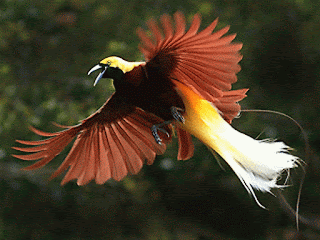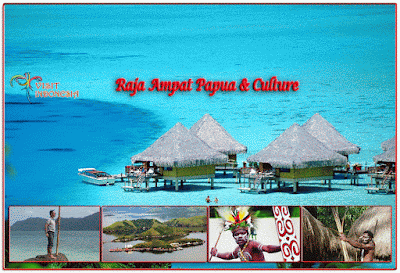West Papua
The Capital City of West
Papua Province is “Manokwari”
West Irian Jaya is a hot, humid island
rising from the sea with some of the most impenetrable jungles in the world and
yet also has snowcaps covering 5,000meter - High Mountain peaks, towering over
glacier lakes. West Irian Jaya is Indonesia's largest and easternmost province
and covers the western half of the world's second largest island. It is a land
of exceptional natural grandeur, with beautiful scenic beaches, immense
stretches of marshlands, cool grassy meadows and powerful rivers carving gorges
and tunnels through dark and dense primeval forests. The most heavily populated
and cultivated parts of the island are the Paniai Lakes district and the Baliem
Valley to the east.
The people of the island can be
divided into more than 250 subgroup, which are closely related to the islands
along the southern rim of the Pacific and include among others, the Marindanim,
Yah'ray, Asmat, Mandobo, Dani and Afyat. Those in the central highlands still
maintain their customs and traditions and because of the terrain have virtually
been untouched by outside influences. Communications hove always been difficult
here and different tribes have lived, for the most part, in isolation even of
each other, resulting in an incredibly diverse mixture of cultures.The name
refers to the most western Papua New Guinea. Papua province is also known as
Irian Jaya. Geographical boundaries of the province is in the north Pacific
Ocean; Seram Sea in the west; Banda Sea in the south, and in the eastern
province of Papua. Administratively, the province of West Papua consists of
eight counties and one municipality of the district Fak-fak, Kaimana, Wondama
Bay, Bintuni Manokwari, South Sorong, Sorong and Raja Ampat and Sorong
municipality. The province has 103 districts, 47 villages and 1153 villages.
West Papua is a province with the
capital city of Manokwari, and has many attractions such as the object of
Nature Tourism, History, Cultural Tours, Special Interest Tour, Culinary
Tourism, Sports, Travel Shopping, of the many objects that West Papua is famous
natural attractions Raja Ampat waters, the island Mansinam, Tapurarang
Archeological Site, and the Bay of Triton. The province also has the potential
of natural resources that abound including plantations, mining, forest
products, and eco-tourism. Pearl and seaweed is a staple item in commerce in
Raja Ampat. Meanwhile, South Sorong district is the only producer of a unique
traditional woven cloth called timor clothes. West Papua has the Paradise Bay
National Park is located in Wondama Bay District and major natural
merupakanwisata in West Papua. Paradise Bay National Park stretches from the
eastern peninsula to the northern island Kwatisore Rumberpon with a long
coastline of 500 km, reaching 68 200 ha land area, 1.3853 million ha of sea
area with details of the 80,000 ha area of 12
400 ha of coral reefs and sea.
E-Maily this is where you should not
miss coming to enjoy the beauty of the beaches in marine tourism in Raja Ampat.
In West Papua has also been found by a French expedition team speologi a cave
that is claimed as the world's deepest cave. This cave is estimated to reach a
depth of 2000 meters. Located in the Mountains Lina, Irameba Village, District
Anggi, Manokwari. Mountainous region of West Papua's natural wealth is still a
mystery and beauty that was amazing.The
colors that appear because of the influence of coral reefs in the shallow sea
bottom or inside. They were enjoying lunch at the Papua Diving Resort, West
Irian Jaya f waters.Hot sun and brisk air makes exasperated guests to dive and
dive again. Sunlight often penetrate the crevices of sea waves up to the reef.
Beauty scenery and marine life does make a lasting impression for tourists. For
lovers of coastal tourism and underwater fanatic, Raja Ampat are very well
known even considered the best in the world for the quality of coral reefs.
Many international
underwater photographers capture the charm of the sea Raja Ampat. Some even
come over and over again and make a special book about the beauty of coral
reefs and marine life of this region. Mid-2006, a special team of the world's
leading scientific adventure magazine, National Geographic, create coverage in
Raja Ampat which will become the main report in 2007.The beach is located in
the constellation of the Raja Ampat Islands, Irian Jaya is a tourist place a
great choice for lovers of diving. Where islands are located in the western
part of Irian surrounded by coral reefs and filled with fish.
Tourism in West Papua is an expanding industry but it
brings with it the potential to exploit indigenous West Papuans, both
culturally and economically. Virtually all tourists who come to West Papua
travel to the Baliem Valley in the highlands. The main town, Wamena, draws
tourists who are interested in trekking and in the culture of the local Dani
tribes. Unfortunately, that interest in the culture is often exploitative, and
the Indonesian administration of the tourism industry is mostly concerned with
economic return. Tourists are mostly
Dutch and German, with Australians conspicuously absent, probably due to the
minimal press West Papua attracts. Most tourist money goes to Indonesians who
run the losmen, hotels and small businesses, While the local Dani people can
only earn cash through petty trade at the vegetable market or by haggling with
tourists over everything from the price of a photo to their occasional work as
guides.
The indigenous people are treated as objects of
curiosity. Although the Indonesian administration has previously tried to force
them to wear clothes and live a more "civilised" lifestyle, today
they are happy if they go naked because it is good for tourism. Nowadays, when
villagers can afford it, the custom is to sport modern dress, cotton shorts,
t-shirts and dresses. Government policy, the missionaries and now tourism have
taught the locals to see traditional dress as backward, something to be ashamed
of.In the village of Manda for example, clothed villagers are barred from the
village while near-naked tribes-people, well-rehearsed and divided into two
twelve-member teams, cook and dance in the traditional way for camera carrying
tourists. The tourists pay for the food, the dancing, the photos, some
handicrafts and a night's accommodation. The next day, after the tourists have
left, the villagers climb into their clothes again clothes bought using the
profits of tourism.
Biak, an island off the north coast, receives luxury
liners because it is one of the world's best diving spots. A five star resort
opened there in 1992, laying the groundwork for direct QANTAS flights from Australia,
with a golf course, marine park and five luxury hotels. Tourism can provide
opportunities for indigenous people to obtain cash and develop their
livelihood, while respecting their tradition. The village of Dukun for example,
man- ages its own co-operative venture formed to profit from tourism, yet helps
them feel pride in their culture. Here, self-determination helps to sidestep
the culture shock. Tourists can stay in a village, completely built by the
co-operative to house visitors, for Rp 3000 (A $2) a night. The villagers will
dress traditionally, dance and have a feast for paying tourists. Tourism can be
in keeping with the dignity of indigenous people and can help them to feel
pride in their traditions.
You can visit West Papua and discover for yourself the
uniqueness of the country's environment and people. Helpful resources are Kal
Muller's book Indonesian New Guinea, and John McCarthy's booklet, (plus
discussion guide, especially designed for educational use), Are Sweet Dreams
Made of This? (see Reference section).Irian Jaya is a tropical island with primeval rain
forests, powerful rivers, beautiful beaches, lakes, and mountains. The highest
mountain is Mount Jayawijaya, with snowcaps covering its 5,000-meter-high
peaks. The area is also rich in natural resources, including fish, timber, and
precious metals. These, however ever, have become a source of conflict between
the central government and local peoples.
History
Prior to the 16th century and the
arrival of the Portuguese, very little was known in the west about this region,
but trade with the Molucan Islands, Timor and perhaps Java existed long before
this. Within a few years of the conquest of Malacca in 1511 by Portugal, New
Guinea began to appear in western literature. In 1526, the first Portuguese
governor of the Moluccas landed on Waigeo Island in Raja Ampat, and duly
baptised the island 'Ilhas Dos Papuas', or Islands of the Frizzy Haired.
After a few years of unsuccessful
attempts to discover this fabled island of gold, Ynigo Ortiz de Retes finally
landed in 1545, naming New Guinea and claiming it for the King of Spain.
Several failed gold explorations followed, but it was only in 1714 that Spain
was forced to relinquish 'control' to Holland and England. The Dutch and
English had long been interested in the Papua Province's trade commodities of
nutmeg, massio bark, trepang (dried sea cucumbers), tortoise shells, pearls,
birds of paradise skins and slaves. The British finally proclaimed a
Protectorate at Port Moresby in eastern New Guinea in 1884, the same year as
Germany raised its flag on the northeast coast, with the Dutch establishing 2
permanent posts in the west at Fakfak and Manokwari in 1899. The boundaries
were settled in 1895 and 1910.
If Papua Province, or Netherlands New
Guinea, as it was known then, was ignored by the Dutch, it wasn't by others.
Sir Alfred Russel Wallace spent 8 years in the archipelago between 1854-1862.
He postulated the bio-geographical boundary dividing Asian and Australasian
species, now called the Wallace Line, and was responsible with developing a
theory of evolution at the same time as Charles Darwin. Serious exploration of
New Guinea's interior was only begun at the start of the 20th century, when
contact with many of the island's tribes was first made. However, it was World
War II that finally put New Guinea on the map in western history, when it
became a fierce battleground between the Japanese and Allied forces. The final push
came at the Bird's Head Peninsula, and this area is now home to some fantastic
WWII wreck diving opportunities.
With the end of Word War II came the
Dutch hand over of territories to Indonesia. However, conspicuously absent from
this list was Dutch New Guinea, which was only ceded in 1969 and renamed Irian
Jaya in March 1973. Since then the OPM, or 'Free Papua Movement' has campaigned
for independence, and the Indonesian government is still reluctant to open some
Papuan areas to tourism.
Society and Culture
The house is very unique native
Papuans. In Papua, traditional houses called honai with roofs made of coarse
grass and walls made of wood with no windows. Papua is a traditional musical
instrument atowo, drums and fu. Unique items from Papua is koteka cover male
genitalia is made from a dried gourd of water. The size and type of activity
koteka bekaitan with the wearer, whether to work or ceremony. Koteka used when
working short and long koteka decorations used during traditional
ceremonies.Another interesting aspect of the culture and history of Papua is a
mummy, usually only the chiefs or warlords who mummified with traditional
materials to glorify the history and religious interests mereka.Ada 3 mummies
that we can see in Papua; Aikima in Aikima mummy, mummy Jiwika in Jiwika and
mummy Purno in Asologaima. The third mummy was in Wamena. There are 24 tribes
in Papua, which has a different language. Connected with the ethnic Papuan
Asmat and Dani. Handicrafts are famous Asmat wood carvings famous beauty to the
world.
The province is divided according to
tribe who live in an area. The population of each tribe scattered in various
areas. For example, Arfak tribes inhabiting the mountainous region of pemukman
Manokwari Arfak to Bintuni. Doteri tribe is a group that moved on the island
Numfor Wondama settlements in coastal areas. Kelommpok other tribes who live in
this area is a tribal Kuri, Simuri, Irarutu, Moscona, Mairasi, Kambouw, Onim,
Sekar, Maibrat, Tehit, Imeko, Moi, Tipin, Maya and Biak.
Culinary
Papeda is the typical food of the most
famous Papua. Papeda like porridge and most enjoyable hot. How to eat it is to
swallow rather than chew it because it directly like glue. Papeda made of sago
is made to take a while because the people of Papua have to cut down sago trees
first, then cut and collected on the inside and then cooked. Papeda will taste
better if eaten with fish sauce, yellow.
Population
The province has a population of
approximately 800,000, making it one of the least populous of all Indonesian
provinces. The capital of Irian Jaya Barat is Manokwari. The most populated and
cultivated parts of the island are Paniai Lake district and Baliem Valley to
the east. The population comprises migrants from Java and indigenous people from
diverse tribes, such as Dani of Baliem Valley in the central highlands, Asmat
of the southern coastal region, and Ekari of Wissel Lakes region. The official
language is Indonesian, but the indigenous people, reflecting the isolation and
small numbers of the tribes, speak at least 250 languages.
The People
Black-skinned, hirsute and
frizzy-haired, the Papuan people are very distinct from the other Indonesian
peoples. Just when these 'Papuans' (relatives of Australia's aboriginals)
arrived here is a matter of conjecture. Also unknown is where they came from. One
theory has it that they migrated from Africa, and others believe they evolved in
situ. The most widely accepted dates for earliest man in New Guinea is
around 35-40,000 years ago, and they have remained isolated from their
Australian cousins for at least 10,000 years.Even within New Guinea itself,
various Papuan groups evolved in relative isolation from one another. This was
due to the mountainous terrain but also the states of perpetual warfare that
many groups had with neighbours, resulting in New Guinea occupying only 0.01%
of the world land area, but contributing 15% of its languages! In Indonesian
Papua alone there are 80 different languages spoken by its 1,000,000 people.
Austronesians (Malayo-Polynesians)
first appeared in the Indonesian islands around 5,000 years ago, and gradually
displaced the Papuan populations over the next 2 millennia. However, they never
penetrated into central region, but intermixed with Papuans along the coasts
and islands, imposing their languages. The Papua Province's malarial lowland
swamps have sago and an abundance of fish, inhabited by swamp dwelling tribes.
The best known of these are the Marind-Anim
and the Asmat, infamous for
their former headhunting and ritual cannibalism.
In the inland foothills and valleys
various tribes practice gardening, pig husbandry, hunting and gathering. In
some of the jungle areas, cannibalism is still frequently reported and some
groups reject Western influence. The highlands are home to the various and
famous Danitribes. These are the
penis-sheath wearers that farm pigs, and sweet potatoes. In the isolated Silimo
Valley live the Jaletribe. Once
again, penis gourds and eating visitors play an important role in their
culture, and cowrie shells were an accepted form of daily wage as late as the
1960s (oh, for those days at Dive The World). Further to the west are regions
occupied by pygmy tribes and the Ekari-
Papua Province's very own polygamist and capitalist pig-farmers.
Goverenmet Administration
The province contains one city,
Sorong, and 8 regencies are:
- Manokwari
- Fak Fak
- Sorong Selatan with its capital is Teminabuan
- Raja Ampat with its capital is Waisai
- Kaimana
- Bintuni Bay with its capital is Bintuni
- Wondama Bay with its capital is Rasiei
- Sorong Regency
- Sorong city
The objects of interest are:
=====o0o=====



























